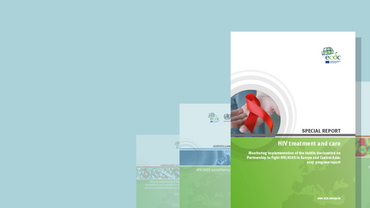Continuum of HIV care - Monitoring implementation of the Dublin Declaration on partnership to fight HIV/AIDS in Europe and Central Asia: 2021 progress report
By 2021, 48 of 55 countries in Europe and Central Asia provided data on at least one stage of the continuum of HIV care (compared to 40 countries in 2018). A total of 47 countries were able to provide data for at least two consecutive stages of the continuum (compared to 45 in 2020) and 40 countries provided data on all four stages.
Executive Summary
- By 2021, 48 of 55 countries in Europe and Central Asia provided data on at least one stage of the continuum of HIV care (compared to 40 countries in 2018). A total of 47 countries were able to provide data for at least two consecutive stages of the continuum (compared to 45 in 2020) and 40 countries provided data on all four stages.
- By 2021, the overall performance of the European and Central Asian region against the global 90-90-90 targets was 82% of all PLHIV diagnosed, 85% of those diagnosed with HIV on treatment and 92% of those on treatment who are virally suppressed. Overall, 64% of all people living with HIV are virally suppressed, which falls short of the target of 73% of all PLHIV being virally suppressed.
- Substantial variation exists for each element of the continuum, both between and within European and Central Asian sub-regions. Overall, the West sub-region met all of the global 90-90-90 targets, with 90% of all PLHIV diagnosed, 95% of people living with diagnosed HIV on treatment, and 93% of those on treatment virally suppressed. The equivalent figures for the Centre sub-region were 85%, 77% and 64% and for the East sub-region 77%, 78%, and 93% respectively. At 79%, the West sub-region met the global substantive target of having 73% of all PLHIV virally suppressed, while the Centre and East sub-regions still have a great deal of progress to make, with all PLHIV virally suppressed at 42% and 56% respectively. Each sub-region showed improvement in the outcomes for the continuum of care in 2020 compared to 2018. Among countries that reported all four stages of the continuum for all years, the proportion of all PLHIV who are virally suppressed increased from 23% by 2018 to 33% by 2020, and to 56% by 2021 among the countries able to report data for all years. The number of people with transmissible levels of virus can be calculated by adding the number of PLHIV who are estimated to be undiagnosed, diagnosed but untreated and treated but not virally suppressed. Using data from the 40 countries that provided for all four stages of the continuum, by 2021 this was estimated to be 821 069 PLHIV in those reporting countries, or the equivalent of 36% of all PLHIV.
- The EU/EEA as a whole achieved two of the three 90-90-90 targets by 2020 (88% of people living with HIV were diagnosed, 93% diagnosed started treatment and 91% of those on treatment were virally supressed).
- Of the people living with transmissible levels of virus in 2021, 51% were estimated to be undiagnosed, 35% were estimated to be diagnosed but untreated and 14% were estimated to be on treatment but have an unsuppressed viral load. This indicates that an equivalent impact in reducing the number of people with transmissible levels of virus could be achieved through rapid and sustained scale-up of treatment and care, as could be achieved by continuing efforts to reduce the undiagnosed population through testing.
- An increasing number of countries can provide population-level data. While outcomes for MSM and migrants are broadly in line with national outcomes for all PLHIV (including only like-for-like countries), outcomes for people who inject drugs and sex workers were lower on average when compared to the overall national picture.







